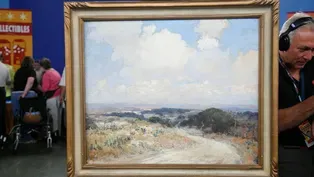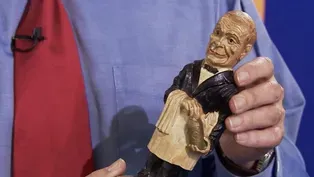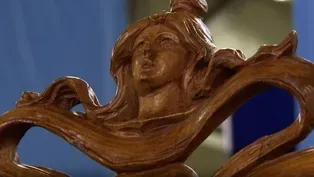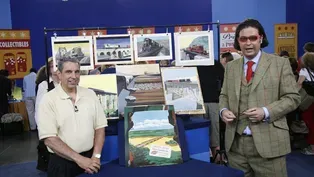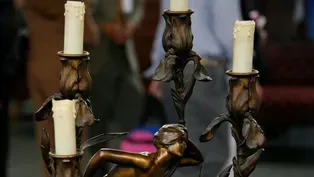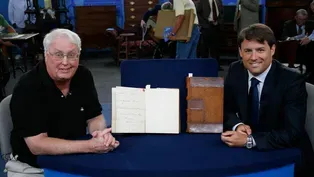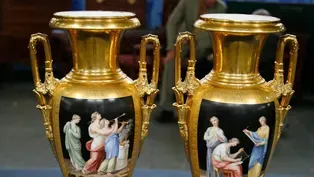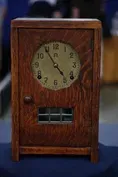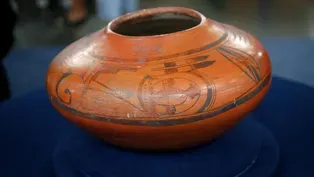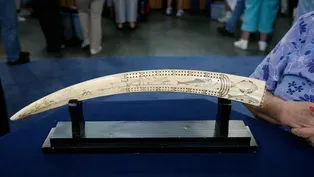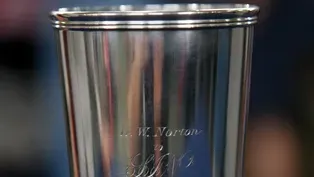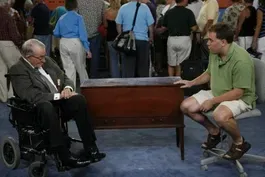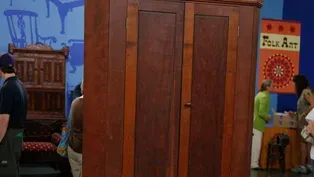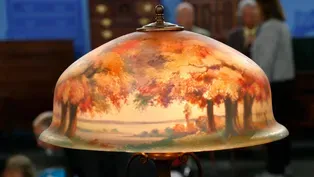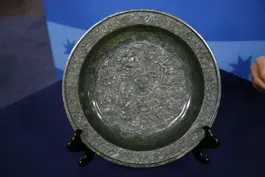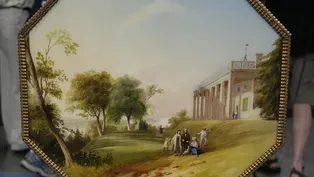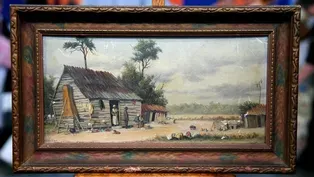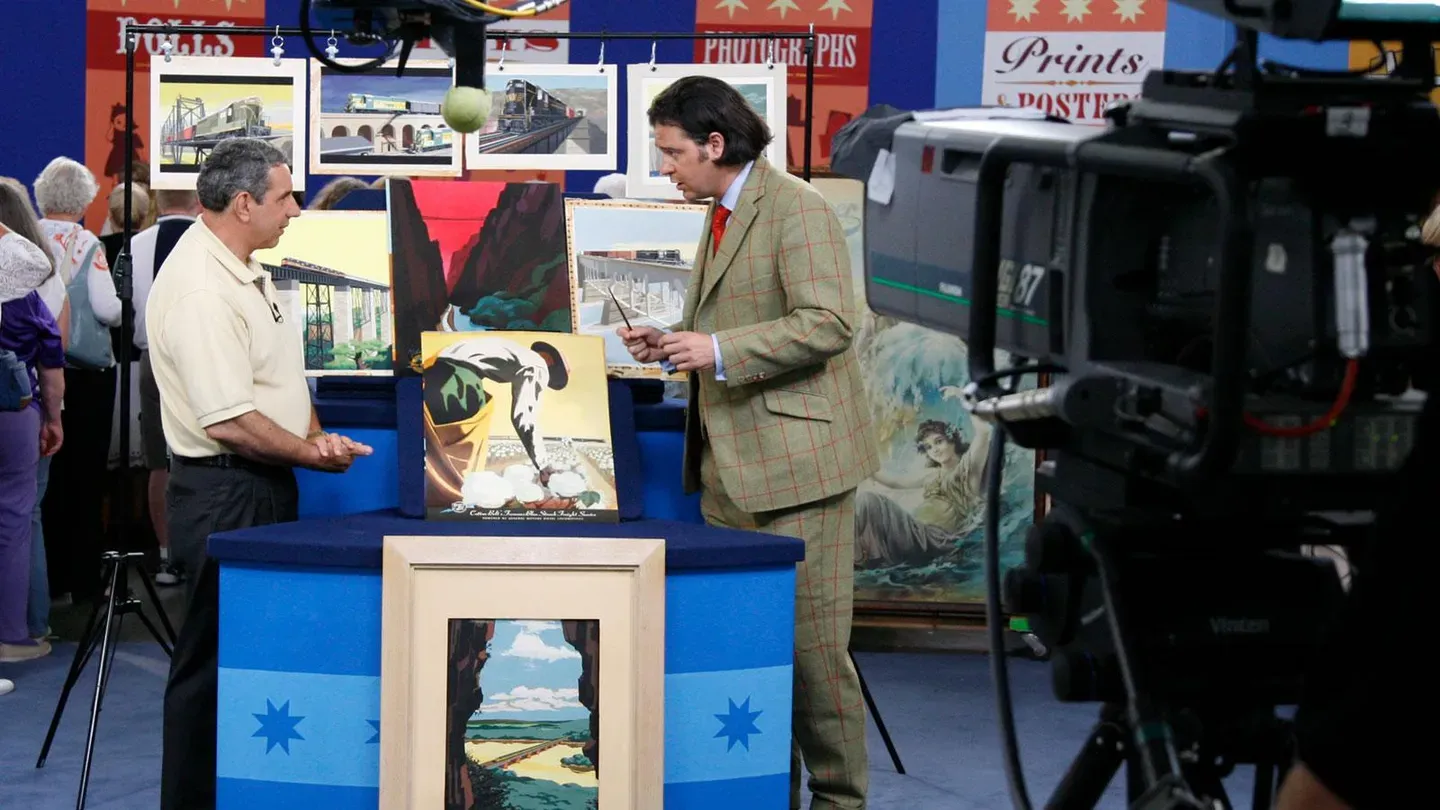

Vintage Louisville 2021, Hour 2
Season 25 Episode 11 | 52m 31sVideo has Closed Captions
Look back at Louisville treasures including an appraisal that has skyrocketed to $125K!
Look back at Louisville treasures from 2007 including a Kentucky cherry corner cupboard made around 1815, a Qing period nephrite jade basin, and a 1911 Julian Onderdonk landscape oil. Which has skyrocketed in value and is appraised for $125,000?
Problems with Closed Captions? Closed Captioning Feedback
Problems with Closed Captions? Closed Captioning Feedback
Funding for ANTIQUES ROADSHOW is provided by Ancestry and American Cruise Lines. Additional funding is provided by public television viewers.

Vintage Louisville 2021, Hour 2
Season 25 Episode 11 | 52m 31sVideo has Closed Captions
Look back at Louisville treasures from 2007 including a Kentucky cherry corner cupboard made around 1815, a Qing period nephrite jade basin, and a 1911 Julian Onderdonk landscape oil. Which has skyrocketed in value and is appraised for $125,000?
Problems with Closed Captions? Closed Captioning Feedback
How to Watch Antiques Roadshow
Antiques Roadshow is available to stream on pbs.org and the free PBS App, available on iPhone, Apple TV, Android TV, Android smartphones, Amazon Fire TV, Amazon Fire Tablet, Roku, Samsung Smart TV, and Vizio.
Buy Now

ANTIQUES ROADSHOW 2025 Tour!
Enter now for a chance to win free tickets to ANTIQUES ROADSHOW's 2025 Tour! Plus, see which cities we're headed to!Providing Support for PBS.org
Learn Moreabout PBS online sponsorship♪ In ten sentences, you've told me more than I've ever known about this.
Oh, that's terrific.
(chuckles) (gasps): Holy cow!
(chuckles) Oh, my gosh.
(laughing): I want to cry.
You made my day.
You made mine!
Okay, good.
♪ CORAL PEÑA: When "Roadshow" visited Louisville back in 2008, we were ecstatic to be greeted by a number of treasures local to the Bluegrass State, including this sweet Kentucky corner cabinet.
Can you guess if the value of this cherrywood storage space went up, down, or stayed the same?
Find out now in "Vintage Louisville," hour two.
It's been in the family for years.
Actually, it used to sit on my back porch with one door missing on it.
A covered porch, I hope.
Yes, yes, yes.
Because it's in pretty good shape, right?
And we thought about actually burning it one time.
Why'd you think of burning it?
Well, it just sat up there, you know, old stuff, furniture.
It gets kind of old, sets around a long time.
You kick it around, you just wanna chuck it away sometimes.
And you said the door was missing?
Yes, we did have a door replaced.
You had the door replaced.
We thought it was made by Thomas Lincoln.
Thomas Lincoln, of course, being Abraham Lincoln's father.
Right.
Right, who worked in the early 19th century, in part, right here in Kentucky.
He was a cabinetmaker, he was a carpenter, and there are a few cupboards that are known out there.
But what I can tell you that you have is this large-- I say large corner cupboard.
It's actually smaller than most.
What do you use it for in your house?
Well, actually, Mom kept toilet paper and a little snort of whiskey in there every now and then, and Dad's folded-up flag in there.
Here in Kentucky, in the early 19th century, when this was made, somewhere between 1795 and 1830, cupboards were essential.
You need, you stored all sorts of provisions, and out in the country-- in Central Kentucky, where this was probably made-- they usually didn't have glass doors.
They had these solid doors, and that would help keep the light out to preserve things better.
So let's, if we start at the top, we have this arched cornice molding.
Right.
A bold molding, which you often see on Kentucky furniture.
And this is one of my favorite parts.
These arches, they're lightwood inlays which would have been done with a compass to make that incised line.
Uh-huh.
And cut a channel out to put that lightwood in.
So these arches are a really nice touch, and that cost a bit extra.
Now, let's come down a little bit, and you look at this cherrywood, a locally grown wood.
Yeah.
These are nice cherrywood doors with contrasting framing members.
Uh-huh.
It's mortised and tenoned in, and here you can see the pin.
And you come down here to this lower section.
You can call this a rope twist.
See that inlay here?
Uh-huh.
Now, you're missing a bit of it.
Yeah, this sides are gone, yeah.
You see how some of it's gone there?
Yeah, and you're missing it on this side, but come down to the lower part, you also have these paneled doors, and then this base with these bracket feet.
Now, while we're down here, let's open up this door.
You've got the nice poplar wood in here.
Now, poplar, tulip poplar, it's a local wood.
They use it a lot for secondary woods.
And that's what the shelves are, that helps us put it in Kentucky.
Now, this is the door that you had replaced?
Yes.
The nice thing is, it looks like he preserved the center panel.
He made the new framing, but he reused that panel because it matches this panel.
Uh-huh.
And all he did is rechamfer it a little bit.
So let's shut it back up here.
So...
The nice thing about Kentucky furniture is that there's so many people down here that love to collect it-- it has a great local interest.
Right.
If this were a cupboard from New York, from up in New England, it really wouldn't be worth as much as it's worth in this market.
Even with the condition issue here with that door, in a shop down here, retail, because it's small and because it's Kentucky, I'd say a reasonable price would be $8,500 even with that replaced door.
Okay.
So if you could prove that-- and some research needs to be done...
Right.
That it's by Thomas Lincoln...
Right.
...this could be worth a multiple of that, of course.
Well, I sure do appreciate it.
I started collecting this about ten to 15 years ago.
It's an Art Deco type of motif that was used on the cover of "Railway Age" magazine from about 1950 through 1956.
The artist is Bern Hill.
The people at our plant-- I work for Electro-Motive, the people who make locomotives-- never really liked this, because he tended to minimize the locomotive and put a lot of the background into his paintings.
But from what I understand, Hill liked to try to capture the essence of a railroad in his scenery.
All of this artwork was actually thrown away at our company and rescued by other people.
As I saw the pieces for sale in private collections, I would buy them, one, two, or whatever.
In this collection, you have some original artwork and you have some of the actual posters.
One of the artworks you've brought by Bern Hill-- and everything, as you said, is by Bern Hill-- is this piece hand-signed by him, as some of the others are.
And we also have here the poster that was created after the artwork.
Yes.
And I know you're fairly familiar with the value of these posters through your work on the internet.
So the values of these posters you think are...
Anywhere from between $1,200 to $2,200 each.
I'm gonna go with the upper end of what you think to be the estimate, and estimate them at $2,000 apiece.
Oh.
And I just want to go through some of the images, because they are so unique.
I've never seen any of them before.
I think it's something exciting for other people to look at, such as the Modernist design-- the shadow of the bridge, in this case.
Here, we have a very European-style low vantage point, with a big wheel of one train in the foreground and the engine.
They keep going and going and going.
Here are some beautiful pastel images of the Southwest for the Santa Fe Railroad.
Truly, an exceptional collection of posters.
But your question today wasn't about the posters.
Your question was more about the original art.
Absolutely.
You were having trouble pricing the original artwork.
Yes, I have no idea at all.
I'm just gonna show a few more of these absolutely colorful and fantastic and graphic images.
As far as the value on the original artwork goes, and we have here two other poster studies, and we have here what we call locomotive portraits along the top.
Okay.
Do you want the good news or do you want the bad news?
All of it.
I'm going to give you the bad news first.
Okay.
I cannot explain this to you.
I can only tell you it's a matter of fact... Yeah.
...that within the poster community...
Yes.
...the original artwork for posters tends to sell for less money than the poster itself.
Now, this is counterintuitive, I know.
Yeah.
But all the times that I've sold-- we call them maquettes, which means the, it's the French word for the study for the poster-- maquettes in the artist's own hand, the originals tend to sell for less money than the actual posters.
That's pretty amazing.
That's the bad news.
Okay.
Here's the good news.
Okay.
The good news is that these images actually transcend the poster market.
Okay.
They touch on railway memorabilia.
They touch on Modernism.
They touch on great graphic design.
From the 1950s, most of them.
Yes.
In my estimation, the original studies for the posters themselves are worth, at auction, $3,000 to $4,000 apiece.
Oh, wow!
And the little train profiles, or little train portraits, are worth between $1,000 and $1,500 apiece.
Okay, that's good.
And with the 12 posters, with a value of $24,000.
Okay.
What's the most you paid for one of the original pieces?
$500 for the one in the front.
I paid a dollar apiece for the posters.
A dollar apiece is a good, you know... You're buying them for a dollar and selling them for $2,000, you're doing all right.
I think I'll do fine.
APPRAISER: It really was made to go in the middle of a table, a relish dish.
Someone said, "Pass me the relish," you just rolled it across the table.
We used to use it for passing the rolls.
APPRAISER: They're woven wires, and they have these great wire twist terminals set with tiny little rubies.
But the history on this style of bracelet goes back to the Etruscan tombs that were being opened up in Italy.
Right.
Looks like Cleopatra, doesn't it?
Exactly.
APPRAISER: This is the style 331 made in 1971, and what's very interesting about it, it's called the Light Show Guitar.
WOMAN: Mmm!
When you play it... (picks and plays chord) It lights up.
Right.
WOMAN: I love Art Nouveau, and about 17 years ago, when I went into an antique show, I saw this chair and I thought, "Oh, my goodness, it's gorgeous"-- I had to have it.
It's a fantastic chair, and in a lot of ways, it's perfectly representative of Art Nouveau.
At the end of the 19th century, the idea came up to use nature as inspiration.
People loved it.
People used it in glass, they used it in furniture, they used it in lighting, and it became a very popular thing.
It was very short-lived.
By 1910, it was in steep decline.
It was actually taken over by Modern, which was even a more radical idea at the time.
As a single chair, it's worth about $3,000 to $4,000 in today's market.
Okay.
As a set... Oh, that would've been nice, yeah.
A set of eight would probably be worth between $20,000 and $25,000.
Okay, well, I paid $1,000, so I think $3,000 to $4,000 is good.
You did great.
I'm excited.
APPRAISER: These two volumes you inherited from your ancestor, who was the actual author of these journals.
MAN: That's right.
They were passed to me from my dad.
They've been historically passed down to first son, to first son.
We'll look at the title page, where it says it's a journal of a cruise in the United States Ship Peacock, South Sea surveying exploring expedition.
William Hudson, Esquire, Commander.
Hudson was the commander of the Peacock, which was one of the ships under the overall command of Charles Wilkes, who from 1838 to 1842 was the commander of the United States exploring expedition.
It was one of the largest exploring expeditions ever mounted by the United States, and one of the first mounted by the United States Navy.
Is that right?
Now, your ancestor was a prominent member of the crew, and he kept this journal, which you can, you can see is incredibly detailed.
There's not a single page in these two volumes that isn't written in this dense hand.
The purpose of the exploring expedition was to go to the Pacific Ocean, primarily, and survey it for the whaling and seal industries.
It explored 280 islands in the Pacific.
Goodness.
It explored 800 miles of the Oregon coast.
And you might not know this, but while they were in the Northwest coast, Charles Wilkes himself named an island after your ancestor in, in Washington.
Oh, he did?
He did.
He did.
Oh, I didn't know that.
One of the most interesting things is the journey from Australia to Antarctica.
You see the beginnings of the journey from Port Jackson, Australia... Ah.
Into the southern waters, which got quite cold, as you can imagine.
These next few pages are amazingly detailed in their discussion of the icebergs and the floes.
They went back north in the Pacific, and the following year, the Peacock actually was wrecked.
Yes, I read-- I read about that.
On the coast.
And here he talks about the ship being wrecked in July of 1841.
All of the crew and all of the supplies had to be brought ashore and transferred to another one of the ships, the Oregon, and they continued.
One of the purposes of the expedition was to bring back specimens.
60,000 specimens were brought back, which became the foundation for the Smithsonian Collection.
Holy cow.
Now, the official account of this was published in 1845, published under Wilkes' own name.
That book brings in the neighborhood of $2,000 to $3,000.
But a firsthand account like this, in manuscript, is quite unusual, and especially given the rich detail.
It's not just recording the weather and the wind patterns.
It's recording encounters with Natives, what happened to the ship, what the land looked like.
How do you put a value on it?
It's very difficult, and I know it's something that you probably would never consider selling.
Yeah, no.
I would estimate it for auction at $15,000 to $20,000.
For insurance purposes, I would suggest a figure of $30,000.
It's absolutely outstanding.
A firsthand account from the most significant American naval expedition of the 19th century.
Thank you so much.
Thank you so much.
Uh, in ten sentences, you've told me more than I've ever known about this.
Oh, that's terrific.
(chuckles) WOMAN: It's a family heirloom.
I inherited it from my great-aunt.
APPRAISER: And it has some information on the back about the location, which is South Texas.
Do you have a connection with... No.
Is the family connected... We're from California.
It's signed down here Julian Onderdonk.
He was born in San Antonio, and his father was an artist, Robert, and that was his first art teacher.
And when he was 19 years old, he went up to New York to study at the Art Students League, and he also studied under a famous American artist named William Merritt Chase.
And William Merritt Chase had an approach to painting which was called plein air, which meant that you painted outside, and he emphasized painting the impression of the landscape rather than specific details.
And I think you can see here that that's what Onderdonk tried to do.
And in 1909, Onderdonk went back to San Antonio, where he continued to paint all kinds of landscapes.
He became really well known for painting bluebonnets, which is a very popular subject for Texans.
At the same time, he had a job with the Dallas State Fair Association, which required him to go back to New York once a year.
And this was actually very helpful for him, because he got to be very well known in New York, as well as in Texas.
So I think this is a really nice example of his work, and one nice detail here is this rider on the road going off into the distance.
He also was known as the father of Texas painting.
He's a very important artist in Texas.
I think that if you were selling this in a gallery, it might bring as much as $75,000 or even as much as $100,000 in Texas.
So I think you have a very nice picture.
(voice breaking): Goodness.
Thank you.
My goodness.
MAN: As far as I know, they came from Europe.
They were brought back by my ancestors sometime prior to 1835.
I had an ancestor over there was buying a lot of paintings, and so on and so forth.
And these were two of the items that he sent back to other relatives in this country in the Boston area.
What I've always heard is that they're Sèvres-- I guess you'd call them urns, not vases, when they reach this size-- but I've always heard they were Sèvres.
Have never been able to prove that.
Who told you they were Sèvres?
Some documentation when they appeared locally in the J.B.
Speed Art Museum, and then also an appraisal that I had done about 25 years ago.
Okay, there might be some evidence that would lead us down that line.
Now, what we are talking about here are a pair of very large and very good French urns.
Mm-hmm.
And they are made in the early 19th century, around about 1810, 1820-- probably closer to 1820.
Now, during this time period, what's going on?
The Napoleonic Era is just ending, there's a great sense of the empire being out there, so there is a renewed interest in the Classicism.
If you notice, all the figures in the front are in Classical poses and in Classical dress.
Right, right.
And on the back, you have a group of military trophies that you would expect to find.
And also, which is really interesting, is, you have this sort of two-tone gold to the side.
Mm-hmm.
That's a mark of very, very nice quality, and the handles, as well, which are beautifully molded.
So you have two-tone gold, beautifully hand-painted scenes.
They're a Classical revival-- but unfortunately, on the bottom, what do we have?
We have no mark at all.
That's right.
And Sèvres almost certainly would have been marked at this time period.
So they're not Sèvres.
Okay.
But that's okay.
There are a number of very, very fine French porcelain makers in and around this time period, perhaps Darte or Nast that did these urns here, because the painting is very, very good.
You do see that there is a little bit of damage here.
There's a couple of nicks to the gilding.
Right, right.
And it's rubbed a little bit around the base-- those are minor defects, but they will affect the value of it somewhat.
And actually, two of the handles have been restored.
Oh, really?
But they were done very well.
And you had them, you did have them appraised at one point, right?
I did.
And that was... That was a while ago.
A while ago.
Yeah.
And that was $3,500 at that point, so...
Right, yeah.
At auction, I would expect this pair of urns to bring $15,000, so... Wow.
(chuckles): Okay, that's great.
But they're not going anywhere.
If I were insuring these... Mm-hmm.
I would put a value of $25,000 on them for insurance.
I will call the agent in the morning.
(laughs): There you go.
(laughs): Believe me!
APPRAISER: It is a pocket globe, and it's a type of thing that a gentleman who had a library would have, and it's more of a novelty item.
We see a lot of china painting here at "Antiques Roadshow."
A lot of it is rather amateur-like.
Right, exactly.
But for some reason, when you get pieces of Satsuma decorated in this country, it seems to have been done by professional artists.
It's painted by hand and signed and dated 1917.
It's actually a section of ribbon from Napoleon's uniform that would have held an order.
The letter discusses that it came from the time when he died at St. Helena.
Right.
Where he was exiled for the second time.
When I was a kid, we used to call it an old Peter O'Toole.
I can see the likeness to Peter O'Toole.
But in fact, he's an American congressman.
His name was Andrew Volstead, and he's best known for the Volstead Act.
And the Volstead Act is that great act that started Prohibition.
The act was written in 1919, and Prohibition started the following year and didn't end until 1933.
So what better thing to make a caricature of Volstead out of than a corkscrew?
And these were made throughout the Prohibition years.
And you see them, but a lot of people don't really know what they are.
I think it's a great bit of Americana.
And he's in pretty good shape, but they sell for about $100, $150, something like that.
Okay, fantastic.
We purchased this, my husband and I, in probably 1977, '78.
We've seen similar tables, but the thing that differentiates this table from others is this beautifully reverse painted glass scene on the top depicting Mount Vernon.
It's interesting to note that the table that we feel was made about 1860 depicts Mount Vernon when it had just been acquired for preservation purposes...
Okay.
...with $200,000 in donated money by the Mount Vernon Ladies' Association.
After George Washington died, the house very quickly fell into disrepair.
In fact, it was in danger of disappearing altogether.
This table is a Rococo Revival table.
The base is made of cast iron.
The top is made of wood, with this ripple-molded surface.
The application of this ripple molding on the edge is something you see frequently in American manufactured furniture from the Gothic Period, the late 1840s up to Civil War time, and that was another means by which we could date the table.
The stunning thing about it is that the top depicts Mount Vernon as it should look, restored, and in fact, it would appear as though these people who are visiting the property are tourists.
They're pointing to the house, they're loving it.
So this was a very interesting example of historic preservation.
Mount Vernon, to my knowledge, was the first important effort in America to preserve an historic property.
The fact that it pictures it so early on I find totally fascinating.
We've seen similar tables with generic tops, you know, flowers or whatever it might be.
But this is so specific.
It also has survived in remarkably good condition.
Somebody went to the trouble of grain-painting the top and the platform for the top to look like an exotic wood.
Right.
Which would've been rosewood.
Right.
Rosewood was used extensively during that period.
They wanted this to look good, even though it wasn't going to show a whole lot.
Mount Vernon during the Civil War was neutral territory.
Even though there was fighting all around here, this was a protected property as early on as that, and it wasn't until 1960 it was declared a national historic landmark.
So what was paid for the table way back then?
We paid about $500 for it.
Yeah.
We had a diversity of opinions, but I think for auction purposes, I would estimate its value somewhere, let's say, in the $8,000 to $12,000 range.
I brought a Stickley clock that was once my grandfather's.
And then it became my father's.
When he passed away six years ago, it became mine.
Although my sister and I kind of-- we didn't squabble about it, but I ended up with it.
You did?
And it's been sitting on the mantel ever since.
When you brought this to the table, we were somewhat excited.
This, to most people, just looks like an ordinary small mantel clock.
And what's really interesting about it is that it was made by a person who really led the Arts and Crafts movement of furniture making, the granddaddy of Arts and Crafts furniture, Gustav Stickley, who worked in upstate New York.
This particular clock is sort of the last of the run that Gustav made himself before his brothers took over the business.
This clock would date anywhere from about 1910 to 1911 and no later than 1915.
What's really interesting is the way that it's constructed.
This particular example is in oak, and it's quarter-sawn oak.
And when you quarter-saw an oak, you get this really fiery grain pattern that you see throughout the case design.
In addition to that, it has these really bold tenons on the side here that come right through, and also this wonderful dovetail detail on the top-- a real cabinetmaker's dream to see work like that.
We actually see that it says "Stickley," and there's a faint joiner's compass mark.
It has the classic simple lines, rectangular shape, up on really bold feet, a very nice knob that sort of slides instead of actually twists, and these leaded glass windows, all really in nice, original condition.
When we open the door up here, we also notice that it has this wonderful metal dial that's engraved and filled with black wax.
And again, we see the compass mark in this location denoting that it's a Stickley clock.
It actually has on the bottom here "Seth Thomas movement."
So Stickley was responsible for the case, and he jobbed out the movement portion of it.
Seth Thomas, at this particular time, was a world-famous clock manufacturer.
He made some very high-quality clocks, and he also made clocks that were affordable to the mass public, as well.
Overall condition, this clock is actually pretty good.
The one negative is that the finish has been cleaned off.
Originally, this would have been stained and then treated with a banana lacquer finish, which has been rubbed off.
It's a very easy finish to sort of rub off and clean away, and that affects the value.
Because of the way that this clock is finished today in oil, I feel pretty confident that this clock would sell in a retail shop anywhere between $3,500 and $4,000.
(chuckles): Oh, goodness, you're kidding.
No.
Wow.
If the finish hadn't been touched, you probably could see... Don't tell me.
(chuckles) ...another 20%.
My mother and father purchased it back in the early '60s from an antique shop in Chinatown in Chicago.
And how much did he pay for it?
$600.
$600-- that was a hefty price in the 1960s to have paid for it.
Yes, it was.
My folks have told me that it could have come from the Ming Dynasty era.
All right.
And that's about all I know.
It's not Ming Dynasty.
It's not Ming Dynasty?
No, and it's Chinese export.
It was made specifically to sell to the West.
Okay.
It was made in South China, probably in Canton Province.
These things were made in a factory kind of environment, produced in fairly large quantities, of which very, very few have survived.
Oh, really?
And it's pottery that's been cold-painted, and it's a Qing Dynasty official.
Okay.
And he's a top-ranking official.
The plaque that's on the front, and there's a reverse one on the back...
Okay.
...are rank badges, and he has a crane on that, which means he's a first-ranking official.
The necklace that he's wearing is a court necklace, and then that cap used to be made out of otter's fur.
Part of the China trade was, they would send us figures like this, and we sold them otter pelts from the Northwest coast.
Okay.
The robe that's underneath there is a dragon robe, and that was an official honor, to be given that robe.
Okay.
And that robe would have been embroidered with dragons everywhere, dragons and pearls.
And it dates probably to the very early part of the 19th century, maybe 1800 to about 1830.
And you can tell that particularly because these figures later on get much, much less realistic.
And originally, he would have had, on the back of the hat, there would have been a peacock feather.
And it has a little bit of damage, but it can be repaired.
And it's not a particularly difficult repair to do.
It doesn't much affect the price of the piece.
I would think at auction, this piece should sell for around $40,000.
Okay, cool.
And wouldn't be surprised at all if it sold for more.
That would be neat.
Yeah.
And there were originally two of them, a male and a female figure.
Right.
And at that, you don't even know what would happen in terms of the price.
It'd be sky-high.
They're exceptionally rare-- I've never seen any of them outside of museums.
WOMAN: Well, it was passed down to me from my mother from her Uncle Donald in Virginia.
APPRAISER: And you have any idea where Uncle Donald got it?
I just know he was a collector.
He collected Oriental art and just a lot of different art.
And did he travel?
I don't know about his travels.
Yeah, because this piece is from France.
It was made in Paris, probably in the 1890s or around 1900.
It's by a fairly well-known French artist from that period.
His name was Maurice Bouval.
He was born in 1863 and he studied with a very prominent sculptor at the time named Falguière.
And he was one of those artists who is not particularly well known now, but he's well known in his period.
He actually exhibited at the Paris Salons, which were these big annual exhibitions of French artists.
And he exhibited starting in the 1890s up until around the First World War.
It's very clearly signed.
It says "Maurice Bouval."
And what's particularly interesting about your piece is that it's also signed with the name of the foundry, which is Thiébaut Frères.
What's unusual is that the signature is actually engraved in the piece.
Most times, the foundry mark is stamped in or punched into the original model.
This was made just at that time when electricity was coming into fashion, and what you have here on the top, these are new plastic covers.
They have new fittings in here, these are new electric porcelain fittings.
And then this is just plastic that's put over it.
In the period, they probably would have just had a socket and a bulb.
It exhibits this wonderful Art Nouveau figure surrounded by these flowers.
This part is called the bobeche.
It's nicely detailed.
I think at one time, this probably had a gold patina on it.
There are traces of gilding on it.
But I think over the years, it's worn off.
And I do have a pair of them.
And you just wanted to bring one into the show?
Yeah, uh-huh.
In terms of the value, this single lamp is worth between $5,000 and $7,000.
Now, since you do have the pair, the pair is worth more than twice of a single.
So, the pair is between $12,000 and $15,000.
Oh, my... Oh, marvelous!
(laughs) It's a beautiful painting, which really speaks to the Victorian period and style, and beautiful details.
And a really great example of Agapit Stevens' work.
It was made by the Birge & Fuller Company in Bristol, Connecticut, and it has the original paper label inside.
Birge & Fuller is significant because they were at the forefront of early brass-movement clock making in America.
These are worn in the Northern Plains by members of the Bull Society in honor of the spirit of the buffalo.
The piece is not right.
This cloth is not exactly right.
The beads that you saw over here... Uh-huh.
...that you thought were Blackfoot, it's really a Sioux style, and the beads here are late.
They're, like, 1930s, 1940s.
If the thing were real, $30,000 to $50,000.
(laughing): Unbelievable.
My daughter-in-law found it when she was cleaning out, helping to clean out her great-aunt's house in New York.
She gave it to me and we thought it was just a piece of junk.
I'm going to tell you a lot about it.
Okay.
But I don't want you to faint.
Okay.
(both laughing) It's very old.
All right.
It's roughly about 2,000 years old.
Whoa!
Are you kidding?
(laughs) I'm not kidding you.
It's only a fragment.
Yeah?
It's part of a bigger piece.
It's a scene on here of sculpture.
Mm-hmm.
And how it's done in relief, it's called repoussé.
Okay.
And how it's done, it's done from the reverse side.
Mm-hmm.
Now, this is 24-karat gold.
Okay.
I work in 24-karat gold, so it's very soft, and you got to be careful.
Okay.
The back is all hammered.
This most likely was a headband.
Oh!
Somebody, somebody made a pendant out of it.
It's Greek.
If you look at the carving on here, it's the king sitting down, and the maids are coming, and they're bringing in another mate.
And this is a satyr... Uh-huh.
...with the tail.
A piece like this in today's market, if it comes up for auction, could easily go for anywhere from $8,000 to $12,000.
(gasps): Holy cow!
(laughing) Oh, my gosh, okay.
You got me today.
Okay.
You got me today.
(laughing) Okay, you got me today.
WOMAN: It was just found in an abandoned house that was going to be tore down.
So there was a lot of trash throwed outside in, in a pile, and this was in the pile of trash.
This was in a pile of trash?
That's really pretty amazing.
The painting is by an American artist who's really a Southern painter, from Charleston, William Aiken Walker.
Walker was born in 1838 and he died in 1921.
While starting in Charleston, he traveled throughout the South.
He traveled through New Orleans, he actually lived for a time in Baltimore, and spent some time overseas in Germany.
Now, his father was a cotton agent, and Walker was essentially considered a self-taught painter, an itinerant painter.
And he did landscapes, he did some still lifes.
But what William Aiken Walker is best known for is really exactly what you have.
Here we have a family.
In kind of a little charming addition, we've got a hog with some, some chickens and roosters.
And then we've got a dog here, sitting right by the foot of the cabin.
He was really popular in his day.
He would go to a lot of these Southern tourist areas, such as New Orleans, and he'd set up shop.
He'd take artists' boards, and he'd actually cut them up to designated sizes, usually this long, narrow size-- although he did do some formats that were vertical-- and he would do a lot of paintings like this, pretty much one after another.
He was very, very prolific.
It's a little bit difficult to peg exactly when it would have been done.
Generally, the paintings aren't dated.
As you said, you found the painting in a house that had been abandoned.
Down the road, a little bit has happened here in terms of some scratches, a little bit of surface abrasions, some losses, and some of the areas in here through the sky a little bit yellowed.
And I think it's the kind of thing that, if it were shown to a professional restorer, it could be very lightly cleaned, and I think it would come out better.
It's a terrific example of his work.
A painting today like this with the condition issues-- which, in the scheme of things, I think are generally minor-- I think this probably a painting at auction that would sell for between $7,000 and $10,000.
Well, it's a terrific thing to find.
You're very lucky.
Oh, yes.
Well, thank you so much, thank you.
Thank you.
I want to cry.
(laughing) Well, that's...
I'm going to be flying high going home.
Yeah, yeah.
MAN: I was at a yard sale in Northern Michigan, and I paid three dollars for it.
What inspired you to buy it?
I'm really attracted to Native American materials: pottery, rugs... Well, this is one of those objects that's rich with potential.
It is a Hopi pot, it's from a Southwestern pueblo.
It's from the First Mesa.
The distinction of Hopi pottery is that the clay actually, it has a very wooden sound, it tends to be very porous, and it tends to be very thick, and this has all of those attributes.
And then the black mineral paint that's on here is quite lovely.
Would you call that redware?
It is a redware.
It could be the work of the premier potter of the Hopi.
Her name was Nampeyo, and she was born in the late 1800s.
And around the 1900s, they were excavating below the mesa a early 1300s site called Sikyatki.
And she became enamored and influenced by the designs of the shards of the pottery that they were finding at these excavations of her culture.
So she began a revival of the Hopi pottery movement.
This could be one of her works.
It's typical of the time, it has the age.
It has some of her famous attributes.
This is actually a bear paw, and it was a very favored design element of Nampeyo.
The interesting thing about Nampeyo, she was also considered one of the prettiest girls on the mesa.
To our advantage, she was photographed a lot, so as her fame grew internationally as a potter, even more pictures were taken of her.
So, the process of determining if this is really her work will be aided by people who specialize in Nampeyo pottery.
There's a really rich potential it could be, and that's because of the sensitivity of the design layout.
It's somewhat of an awkward shape, the way it lops, and they refer to these as seed jars.
There's a sensibility to it that's very charming.
I think if this was to come to auction and it's not a Nampeyo, it would have a value of probably about $1,800 to $2,000.
Now, if we can prove that it's Nampeyo, at auction, she stands to bring anywhere from $10,000 to $30,000.
Thank you for bringing this in today.
It would be wonderful.
It was delightful, and I, I hope it turns out for the very best.
Yes, thank you very much.
MAN: This was a piece that hung in my grandmother's dining room, hung in my mother's dining room, now hangs in my dining room.
I don't really know where the piece came from.
It's one of a few that we have similar, but not quite alike.
Now, where did your grandmother live?
My grandmother grew up in Mayfield, Kentucky.
Now, her dad was a U.S. senator and traveled to Washington, DC, all the time.
I don't know if it came from his side or where it actually came from.
But you said you had a group of these?
Yes.
It's actually from the Mary Balch School of Providence, Rhode Island.
It's quite a wonderful one, one of the most elaborate ones I've ever seen.
It was done around 1800 to 1810.
Wow.
There are several features that are special.
Number one, it's a very large size.
Number two, this wonderful original glass mat, which was painted on the reverse.
It's known as an églomisé mat, which is quite unusual to have the original and the original beautiful gilded frame.
This was done at the school, or the academy, and then the framer would come in with the églomisé panel and the frame, and frame them, usually right in the school.
There are some very unusual features on the needlework.
Number one, it's silk on silk, and also has chenille motifs here.
And the chenille is actually a nubbly type of silk thread, and chenille in French actually means caterpillar.
And if you look down here, it looks like the surface of a caterpillar's skin.
It is what is known as a mourning picture, and these were done when somebody died, and it was a memorial to them.
So I think it's a great New England historic documented piece, done in a known school.
Now, have you ever had it appraised?
No, I have not.
Well, it has a retail value of between $20,000 and $30,000.
Wow.
Because of its all-original condition.
Wow.
APPRAISER: You've a series of land grants from each of the governors, really from the founding of the state.
Patrick Henry, of course, governor of Virginia, was the first person to sign land grants for the State of Kentucky.
APPRAISER: It's called a minute repeater.
It would actually tell the person the time to the nearest minute by a succession of ringing bells.
This watch is a minute repeater which also has a day, a date, a month, and the phase of the moon.
I first saw it in my grandmother's house.
She had a lot of family portraits, which, this is a Dwight family member.
Her name was Laura Dwight Sherrard, and that's mostly what I know about it, other than it was one of her favorites.
Yeah.
Well, it's one of my favorites.
Oh, really?
And I'm not even related to you.
(chuckles) It's a wonderful New England portrait by a artist named John Brewster, Jr. And he was born in 1766 and died in Maine in 1854.
And what's interesting about Brewster is, he was a deaf-mute, and he was apprenticed to a painter, Joseph Steward, and spent his entire life moving throughout New England and ultimately in Maine, painting portraits.
Hm.
And he is one of the most sensitive and one of the most evocative painters that the American folk category has.
Hm.
He always paints with these sort of very subdued gray backgrounds.
This portrait would, at auction, conservatively, be worth somewhere in the vicinity of $40,000 to $60,000.
(chuckles): Goodness, gracious!
MAN: I've been told that this chest is from Fort Harrod, Harrodsburg, Kentucky, and was built by my great-grandfather-- seventh or eighth generation, I'm not exactly sure-- and he was a furniture maker in Fort Harrod, and he was the husband of Ann Kennedy Poague, who was supposedly the first female settler in Kentucky.
Kentucky achieved statehood in 1792.
Would this have been slightly before or slightly after that period?
I was told it was slightly before, but I, but I can't confirm that.
Yes.
There must have been family stories told about this, how it was used in the family?
It was used as a sugar chest.
And open it up to just take a look at the interior of this piece.
What you notice here are three compartments, and the one thing we've discovered from inventories of households is that in general, these three sections would hold white cone sugar, brown granulated sugar... Mm-hmm.
And then unroasted coffee.
Okay.
And these were three of the most expensive condiments in the American home at that time.
We forget, with sugar everywhere today, how difficult it was to come by.
And that's the reason that we have locks on all of the drawers.
One of the responsibilities of a woman in that period was to keep the keys to these kind of locked areas in a key basket or on her chatelaine.
Do you know what the wood is?
I believe it's cherry.
Cherry.
And the secondary wood is tooled poplar.
Okay, I didn't know that.
Which is to be expected in this region.
You see these shadows here?
Yes.
Yes, those were where the wrought-iron hinges held.
And on that side, as you can tell, it ripped out part of the backing.
One of the things that's interesting about this piece, I think, is its large size and its construction.
You notice it has tapered legs.
Some have rounded legs, but the tapered leg is much more a Hepplewhite element.
I would tend to think that this is possibly after statehood.
Okay.
Because the Hepplewhite leg does not come in until the 1780s.
Okay.
And by the time it reached here, it was probably a generation or two later.
I've talked to some of my colleagues, and it's our general opinion that a conservative retail estimate would be about $8,000 to $10,000.
Wow, wow.
Because there is a great interest in this Southern furniture today.
WOMAN: Well, this belonged to my grandfather, and he went to Nome, Alaska, in the early 1900s and built the first hotel up there.
And my grandmother followed later with two children.
And I'm not sure how he acquired this, but I know that he did acquire it from an Eskimo.
I'm not sure as to the dates, but I know that my father went to the first grade in Nome, and they had no schoolhouse.
So the saloon was the schoolhouse by day and the saloon at night.
Nome is right on the coast in the central part of Alaska.
Yes, yes.
It's on the Bering Sea.
And the people in the area are called Inupiaq.
Gold was discovered in about 1899 in the Nome area.
So there was a tremendous gold rush.
Now, you'll be delighted to know I found your grandfather on the internet.
No kidding?
And he was actually listed as a cigar dealer.
(chuckles) So, he was quite an entrepreneur.
Now, the Inupiaq were equally as entrepreneurial as your grandfather.
Yeah.
They had this horde of people coming into Alaska, and they said, "We can sell them things."
Yeah.
And this was one of the things that they could sell.
Now, this cribbage board is made of a walrus tusk, and as you see from the size, it's a fairly mature animal.
Yes.
This scrimshaw style of carving probably was brought to Alaska by the whalers... Mm-hmm.
...in the beginning of the 1800s.
Whaling in the Bering Sea goes back thousands of years, but the non-American whalers were in there in the early 1800s.
They probably taught the Inupiaq how to do the scrimshaw.
So you have these terrific artists at the beginning of the 20th century that were creating these objects for the "tourists" that were in the area, which is your grandfather.
You'll see these Inupiaq scenes on here with the seals.
You have this kind of mermaid here and this very unusual sort of flounder-like fish.
So what we have is, we have an artist that's probably a little bit different.
What totally fascinated me about this piece is, on the reverse, we have a map.
Now, what did you think about this map on the back?
Well, I thought it was the coast of Alaska.
Okay.
It is the coast of Alaska.
What about these spellings?
Well, whoever did it wasn't very literate, and...
Okay.
...got their letters all backwards.
Well, actually, this is a mirror image, and I think he did it absolutely on purpose.
Either this had legs on it, and it was reflecting the mirror image of the map, or he was making a joke.
Yeah.
I think it's very unusual.
I've never seen that before.
I think it's a fascinating object.
I'm delighted that you brought it in.
And a very, very good insurance value on this... Mm-hmm.
...would be $2,500 to $3,500.
And I'm just delighted you brought it in.
Why, thank you.
WOMAN: Well, I bought it at auction in 1993 in Lexington.
My husband and I both are interested in Asian things, I had the opportunity to buy it, and I thought it was a good price.
APPRAISER: Okay.
And I didn't really know for sure what it was other than I thought it was probably some kind of jade.
But it was listed as spinach nephrite.
What did this cost?
Do you remember?
Well, I can't really remember.
And I couldn't find a receipt for it, but I want to say maybe about $800.
Okay.
This is made of jade, which you know.
Yes.
It's carved on the interior with lotus flowers and lotus leaves and branches.
And it's a real profusion of that.
But it is recessed about three inches, so it's a shallow wash basin.
So this actually would have sat on a wooden stand.
Mm-hmm.
And would have had water in it.
Now, the lotus decoration in the center, and also the lotus vines and chrysanthemum on the border, which are accompanied by bats, are all, are auspicious symbols that have connotations of good luck and prosperity.
The color of the jade itself, which is technically called nephrite, often is referred to, because of the dark green color, as spinach, just because of the color.
Okay.
Color.
My sense would be that this was made in China... Mm-hmm.
...during the Qing Dynasty in the late 18th, early 19th century.
The carving is certainly above average.
What are you using it for?
I use it for flower arrangements.
One of the things I've noticed, there's some candle wax.
You're not putting candles in it?
Well, I've had candles next to it, and it's...
I would say that's probably...
Probably not a good idea, okay.
...not a good idea.
Because one of the things that can happen if this, for some reason, were to get hot... Uh-huh, it could crack?
It's possible that this could crack.
Because you'll notice that, for instance, there's a fissure running right here...
Right.
...through this section.
Okay.
And then it's possible that could develop into something, because those are the areas of weakness.
And that's part of the natural... That's the natural features in the stone.
Now, one of the things that's also here that's nice is, you see that there's a continuing lotus scroll on the exterior.
Mm-hmm.
Because that part of it, as it sat in the base, would have been visible from the side.
Mm-hmm.
I would recommend an insurance figure for this of about $25,000.
Oh, my God.
(laughs) Okay.
Okay?
Wow.
$25,000, maybe even $30,000.
Whoa, oh, my gosh.
Okay?
That's what you would be expected to pay if you went to an antique shop that dealt in Chinese art and bought this today.
Really?
Wow, that's amazing.
Okay?
Oh, I'm excited.
PEÑA: You're watching "Antiques Roadshow: Vintage Louisville."
PEÑA: And now it's time for the "Roadshow" Feedback Booth.
I've come here with a, a signed photograph of Elvis Presley that my aunt got when she was 15 years old, and they have valued that at a thousand dollars.
And this print that I thought was a print's actually a picture, and it's worth about what I paid for it.
However, the watch I got cleaning out a desk about 20 years ago in the Navy is worth $1,200.
And it was going to be thrown away, so I'm pleased.
I brought this book, "Horton Hatches the Egg."
It's from...
The book was printed in 1940, and signed by Dr. Seuss about 25, 30 years ago.
And it turned out to be worth between $800 and $1,200, so I'm very happy.
We brought great-great- grandma's hair wreath in, and not only did we find out that, uh, it's worthless, it's also pretty creepy, too.
My wife bought this painting at a shop for 60... She paid $65 for it, and I thought she paid too much.
Turns out, it was worth $6,500.
It's not such a bad deal now.
And I brought grandmother's pitcher, but I broke it on the way here.
But we made it back because the watch is worth $2,500.
This child better get a scholarship, because this is worth a dollar.
And mine was worth $40, so I'll be at work on Monday.
(laughs) Thanks.
We had fun.
PEÑA: Thanks for watching.
See you next time on "Antiques Roadshow."
Appraisal: 1911 Julian Onderdonk Painting
Video has Closed Captions
Clip: S25 Ep11 | 1m 59s | Appraisal: 1911 Julian Onderdonk Painting (1m 59s)
Appraisal: Andrew Volstead Corkscrew, ca. 1925
Video has Closed Captions
Clip: S25 Ep11 | 1m 2s | Appraisal: Andrew Volstead Corkscrew, ca. 1925 (1m 2s)
Appraisal: Art Nouveau Chair, ca. 1900
Video has Closed Captions
Clip: S25 Ep11 | 1m 3s | Appraisal: Art Nouveau Chair, ca. 1900 (1m 3s)
Appraisal: Bern Hill Railroad Posters & Manuscripts
Video has Closed Captions
Clip: S25 Ep11 | 3m 59s | Appraisal: Mid-20th-Century Bern Hill Railroad Posters & Manuscripts (3m 59s)
Appraisal: Bouval Art Nouveau Candelabrum, ca. 1900
Video has Closed Captions
Clip: S25 Ep11 | 35s | Appraisal: Bouval Art Nouveau Candelabrum, ca. 1900 (35s)
Appraisal: Exploring Expedition Journals, ca. 1840
Video has Closed Captions
Clip: S25 Ep11 | 3m 23s | Appraisal: Exploring Expedition Journals, ca. 1840 (3m 23s)
Appraisal: French Porcelain Urns, ca. 1820
Video has Closed Captions
Clip: S25 Ep11 | 2m 19s | Appraisal: French Porcelain Urns, ca. 1820 (2m 19s)
Appraisal: Greek Headband Piece, ca. AD 1 - AD 100
Video has Closed Captions
Clip: S25 Ep11 | 1m 43s | Appraisal: Greek Headband Piece, ca. AD 1 - AD 100 (1m 43s)
Appraisal: Gustav Stickley Oak Mantel Clock, ca. 1911
Video has Closed Captions
Clip: S25 Ep11 | 3m 6s | Appraisal: Gustav Stickley Oak Mantel Clock, ca. 1911 (3m 6s)
Appraisal: Hopi Pot Attributed to Nampeyo, ca. 1910
Video has Closed Captions
Clip: S25 Ep11 | 2m 46s | Appraisal: Hopi Pot Attributed to Nampeyo, ca. 1910 (2m 46s)
Appraisal: Inupiaq Scrimshaw Cribbage Board, ca. 1920
Video has Closed Captions
Clip: S25 Ep11 | 3m 19s | Appraisal: Inupiaq Scrimshaw Cribbage Board, ca. 1920 (3m 19s)
Appraisal: Kendrick Silver Mint Julep Cup, ca. 1850
Video has Closed Captions
Clip: S25 Ep11 | 35s | Appraisal: Kendrick Silver Mint Julep Cup, ca. 1850 (35s)
Appraisal: Kentucky Cherry Sugar Chest, ca. 1800
Video has Closed Captions
Clip: S25 Ep11 | 2m 28s | Appraisal: Kentucky Cherry Sugar Chest, ca. 1800 (2m 28s)
Appraisal: Kentucky Corner Cupboard, ca. 1815
Video has Closed Captions
Clip: S25 Ep11 | 3m 22s | Appraisal: Kentucky Corner Cupboard, ca. 1815 (3m 22s)
Appraisal: Mary Balch School Mourning Picture, ca. 1805
Video has Closed Captions
Clip: S25 Ep11 | 2m 10s | Appraisal: Mary Balch School Mourning Picture, ca. 1805 (2m 10s)
Appraisal: Pairpoint Table Lamp, ca. 1905
Video has Closed Captions
Clip: S25 Ep11 | 1m 1s | Appraisal: Pairpoint Table Lamp, ca. 1905 (1m 1s)
Appraisal: Qing Period Nephrite Jade Basin, ca. 1800
Video has Closed Captions
Clip: S25 Ep11 | 2m 57s | Appraisal: Qing Period Nephrite Jade Basin, ca. 1800 (2m 57s)
Appraisal: Rococo Revival Table Picturing Mount Vernon
Video has Closed Captions
Clip: S25 Ep11 | 2m 41s | Appraisal: Rococo Revival Table Picturing Mount Vernon, ca. 1860 (2m 41s)
Appraisal: William Aiken Walker Oil Painting
Video has Closed Captions
Clip: S25 Ep11 | 2m 27s | Appraisal: William Aiken Walker Oil Painting (2m 27s)
Providing Support for PBS.org
Learn Moreabout PBS online sponsorshipSupport for PBS provided by:
Funding for ANTIQUES ROADSHOW is provided by Ancestry and American Cruise Lines. Additional funding is provided by public television viewers.


